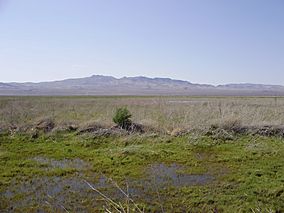Humboldt Wildlife Management Area facts for kids
Quick facts for kids Humboldt Wildlife Management |
|
|---|---|

The salt marsh at the end of the Humboldt River within Humboldt WMA.
|
|
| Location | Pershing, Churchill, Nevada, United States |
| Area | 37,140 acres (150.3 km2) |
| Established | 1953 |
| Governing body | Nevada Department of Wildlife |
| Website | [ Humboldt Wildlife Management Area] |

The Humboldt Wildlife Management Area (WMA) is a special place in Nevada, U.S., where nature is protected. It's home to the salt marshes at the very end of the Humboldt River. This area is managed to help wildlife thrive and is a great spot for outdoor activities.
Contents
Amazing Habitats and Wildlife
The Humboldt WMA has many different types of natural areas. These range from dry desert lands with special plants to wide-open water. You can find three shallow lakes here: Upper Humboldt Lake, Lower Humboldt Lake, and Toulon Lake.
Water Levels and Nature's Changes
The amount of water in these lakes changes a lot. This is because the weather in the Great Basin can be very different from month to month and year to year. Sometimes, like in 1998, there can be a huge amount of water, covering up to 25,000 acres (about 39 square miles). Other times, the whole area can dry up completely. The water that flows into the WMA also depends on how much water farms upstream in the Lovelock Valley use for their crops.
Birds and Other Animals
Even though the water levels change, these wetlands are super important. They are a valuable stop for many migratory birds. These birds fly long distances and need a safe place to rest and find food. Many birds also choose to build their nests and raise their young here.
You can often see different kinds of Ducks, like mallards and Canada geese. American coots are also common. Look out for shorebirds such as the American avocet, and amazing raptors like owls and hawks soaring above.
Some mule deer also live in the area. They hide among the stands of tamarix plants. These plants are considered invasive, meaning they are not native and can sometimes take over.
Fun Activities at the WMA
People mostly visit the Humboldt WMA for hunting. When there's enough water, you can also go fishing. Camping is allowed too, so you can spend a night under the stars. The WMA is open all year, all day and night, and there's no charge to enter.
A Look Back: History of the Area
The land where the Humboldt WMA is located has a long and interesting history. People have lived here for thousands of years!
Ancient History and Early Settlers
Just outside the WMA, there's a very important place called Lovelock Cave. This archaeological site has shown us a lot about the Native Americans who lived here long ago. Scientists found the world's oldest known duck decoys in this cave. These decoys are more than 2,000 years old!
In the mid-1800s, people traveling west on the California Trail came to this area. They called it Big Meadows. It was their last chance to get water and let their animals graze before crossing a very tough part of the journey called the Forty Mile Desert.
How the WMA Was Created
The Humboldt WMA was officially created in 1953. Over time, it grew to its current size of 37,140 acres (about 58 square miles). This happened through different ways, like leases, purchases, land trades, and even donations of land.
Environmental Care and Challenges
Because the Humboldt WMA is at the very end of the Humboldt River, it collects everything that flows downstream. The Humboldt River has the largest drainage basin in Nevada, meaning it collects water from a huge area.
Understanding Pollution and Wildlife Safety
Sometimes, things like sewage (wastewater), water from farms, and water from mines can flow into the river. These can carry pollutants. Over time, these pollutants can build up in the environment and in animals through a process called bioaccumulation. This means that harmful substances can reach high levels in fish and wildlife. If humans eat these animals, it could also be unsafe.
A study done in the 1990s found that levels of certain elements like arsenic, boron, mercury, and selenium were higher than what is considered safe for birds. This shows why it's so important to protect our rivers and wetlands from pollution.


